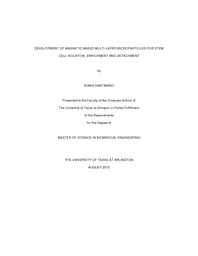
ATTENTION: The works hosted here are being migrated to a new repository that will consolidate resources, improve discoverability, and better show UTA's research impact on the global community. We will update authors as the migration progresses. Please see MavMatrix for more information.
Show simple item record
| dc.contributor.author | Santimano, Sonia | en_US |
| dc.date.accessioned | 2013-03-20T19:10:39Z | |
| dc.date.available | 2013-03-20T19:10:39Z | |
| dc.date.issued | 2013-03-20 | |
| dc.date.submitted | January 2012 | en_US |
| dc.identifier.other | DISS-11819 | en_US |
| dc.identifier.uri | http://hdl.handle.net/10106/11511 | |
| dc.description.abstract | Stem cells have been studied and used in several cell-based therapies for regenerative medicine, 3D tissue-engineered scaffolds, and in vitro models for drug screening and testing. For instance, cell based therapy via the use of stem cells like Endothelial Progenitor Cells (EPCs) to treat patients with cardiovascular diseases, including ischemic heart disease, in-stent restenosis, and peripheral arterial occlusive disease. In addition, Circulating Cancer Cells (CSCs) have been used as an indication of cancer progression-free survival and for studying the mechanisms of tumor formation, metastasis, and anti-cancer drug screening. Due to their extensive diagnostic and therapeutic potential, various techniques have been developed to isolate and expand these stem cells. However, limitations associated with these methods include a low number of stem cells that can be isolated from blood and other sources, the use of harmful chemicals such as Ficoll and Trypsin, and the difficulty in their ex vivo expansion.The objective of this research was therefore to develop magnetic-based multi-layer microparticles (MLMPs) that can (1) magnetically isolate stem cells without the use of Ficoll and harsh shear forces; (2) provide sequential release of proliferating and differentiating growth factors for stem cell enrichment; and (3) finally detach the cell in response to temperaturechanges without the use of chemicals like Trypsin. MLMPs were formulated via layer-by-layer synthesis and characterized for their physicochemical properties. The MLMPs had core-shell structure with a spherical morphology of 50-80 μm, were successfully conjugated with antibodies for stem cell isolation, and provided sequential growth factor release profiles for cell proliferation and differentiation. Moreover, cells were successfully isolated (77% isolation efficiency) from a cell suspension and detached from particle surface (80% detachment in 30 min) by lowering the surrounding temperature below 32ºC. Specificity of isolation was demonstrated by isolating EPCs from a complex cell mixture. In addition, preliminary ex vivo studies with blood was performed to demonstrate the use of these particles for stem cell isolation. Lastly, cell enrichment profiles indicated steady cell growth with MLMPs in comparison to commercial Cytodex3 micro-carriers. All of the above mentioned results clearly indicate the potential use of MLMPs for stem cell isolation, expansion, and detachment with many benefits, highlighting the ease of isolation based on its magnetic property, isolation selectivity and enhanced enrichment owing to the gradual release of growth factors from the MLMP. | en_US |
| dc.description.sponsorship | Nguyen, Kytai Truong | en_US |
| dc.language.iso | en | en_US |
| dc.publisher | Biomedical Engineering | en_US |
| dc.title | Development of Magnetic-based Multi-layer Microparticles For Stem Cell Isolation, Enrichment And Detachment | en_US |
| dc.type | M.S. | en_US |
| dc.contributor.committeeChair | Nguyen, Kytai Truong | en_US |
| dc.degree.department | Biomedical Engineering | en_US |
| dc.degree.discipline | Biomedical Engineering | en_US |
| dc.degree.grantor | University of Texas at Arlington | en_US |
| dc.degree.level | masters | en_US |
| dc.degree.name | M.S. | en_US |
Files in this item
- Name:
- Santimano_uta_2502M_11819.pdf
- Size:
- 926.2Kb
- Format:
- PDF
This item appears in the following Collection(s)
Show simple item record


